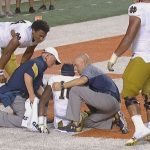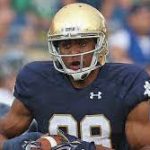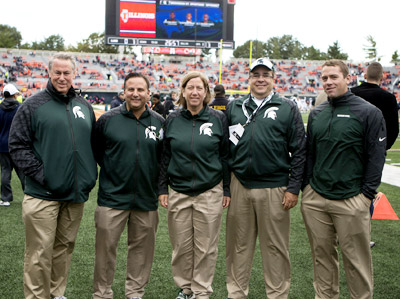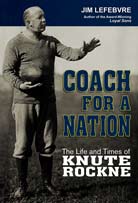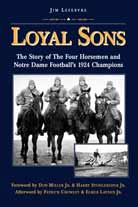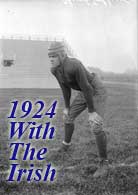It’s an image etched in the consciousness of Notre Dame fans watching the 2016 season opener at Texas. Senior co-captain Torii Hunter Jr. is prone in the end zone, his arms occasionally flailing, while a coterie of teammates and athletic trainers attend to him. Moments later, the camera picks up his dad, baseball great Torii Hunter Sr., mom and other family members, as they are ushered onto the field en route to the Notre Dame locker room.
The diagnosis: concussion, the scourge of modern football. Another famous Notre Dame football father, basketball Hall of Famer David Robinson, watched his son Corey sustain multiple concussions before deciding to hang up his football cleats going into this season.
*****
More than a century ago in Chicago, parents of a lad who had become enamored with neighborhood football games were also concerned about the safety of the sport. Lars and Martha Rockne came by their suspicions over football quite naturally. Headlines in the Chicago newspapers of the time regularly read:
“Killed in the Tackle”
“Deaths from Football”
“Revolt Against Football”
“Death on the Gridiron”
“Bill to Stop Football”
A medical journal called for the abolition of the game, concluding “if we wish to develop pluck, courage, endurance, and strength, we can do so in more healthful and safer ways (than football).”
Eventually, President Theodore Roosevelt called a “football conference” at the White House on Oct. 9, 1905, at which an agreement among the leaders of the sport called for tighter rules enforcement and ultimately led to the creation of the NCAA to govern college athletics. Roosevelt won praise for reforming an activity “of vital interest to the American people.”
*****
That game today stirs the interest of more millions of Americans then ever, some of whom are concerned about its future, given the research that shows the development of cognitive difficulties from repeated blows to the head. Football Hall of Famers Terry Bradshaw and Mike Ditka are among those who, knowing what they now know, say they would not let a family member begin football.
“And my whole life was football,” said Ditka in early 2015. “I think the risk is worse than the reward. I really do.”
Across the nation, parents are faced with the dilemma: do I let my son play football?
*****
Meanwhile, more study than ever is going into the diagnosis, treatment, and affects of concussions. Among the most active institutions at the collegiate level is this week’s Notre Dame opponent, Michigan State University.
MSU’s Concussion Research Consortium is dedicated to “improving the prevention, evaluation, and management of sport-related concussion through research, education, and clinical practice. On-the-field management of concussion in football consists of a consortium approach provided by a variety of disciplines including athletic training, primary care, orthopedics and neurology.”
For Spartan football games the past five seasons, a constant presence on the sideline has been the chairman of MSU’s Department of Neurology & Ophthalmology, David Kaufman, D.O. In addition to games, Dr. Kaufman is present at Spartan practices on Tuesdays (contact) and Thursdays (medical clearance of players) and medical treatment on Sundays.
“It’s a statement the University is making,” Dr. Kaufman said. “They are taking concussions very seriously. To have a neurologist with the team, including away games, is not something every school is able to do. The athletic trainers have said, ‘You’re the insurance policy.’ I’m there to make a judgment call when the diagnosis is not obvious to the athletic trainers or the other team physicians.”
Dr. Kaufman praised the advances made in preventing concussions, including the strict enforcement of ‘targeting’ the head and neck; the teaching of ‘rugby-style’ tackling; the decrease in full-contact practice from twice to once a week (or its outright elimination, as in the Ivy League); and a new program being rolled out by the NCAA and the Department of Defense, at the service academies and a few other schools, to educate student-athletes to speak up…about their own concussion symptoms, as well as those of their teammates.
“There are significant cultural changes,” Dr. Kaufman notes. “These are still incredibly macho warriors, but we want them to be safe warriors. We don’t want to take away the essence of what makes it a great game; the goal is allowing them to play the sport they love, while shielding the player from risk as much as we can.”
MSU researchers have designed an all-sport, all-weather low-tech headband which detects the force of impact to the head. It can be imbedded in a football helmet, but otherwise worn as a normal headband in sports such as soccer.
Dr. Kaufman’s own research delves into connectivity of brain systems after a concussion, and its measurement at various points. It has shown that, even 30 days after some concussions, the connectivity still has not returned to normal. “It’s simply an observation at this point,” Dr. Kaufman explains. “We do not know the clinical relevance as of yet.”
Michigan State’s concussion team is part of a joint effort with several other Big 10 schools, including Ohio State, Nebraska, Northwestern, Penn State and Purdue, along with the University of South Florida. Dr. Kaufman remains one of the few team neurologists on the sidelines in college football; this 2013 New York Times article profiled Dr. Kaufman and his counterpart at MSU’s arch-rival, the University of Michigan.
What is Dr. Kaufman’s advice to parents of prospective athletes?
“I advise people to use common sense,” he noted. “Assess each activity in terms of risk and benefit. And we know the very positive aspects of team sport – learning how to work as a group, learning how to win and lose, how to persist in achieving a goal. Weigh all that vs. the potential dangers. Know that there is emerging science that is changing some sports. The call for limiting ‘headers’ at the younger levels of soccer, for instance.
“There are some individuals who I believe are making inappropriate, non-science based statements. Does one concussion, or a series of smaller hits, imply you will always develop dementia? I think the emerging data will show that is a very uncommon outcome in most student-athletes.”
Dr. Kaufman sees the work of his colleagues at MSU, and other universities, to be critical in the future of football and other contact sports.
“Science will continue to seek ways to make the game safer. Our position: Safety is a key element. Will there always be some risk? Yes, risk is unavoidable in life. We will continue to work to minimize it.”
